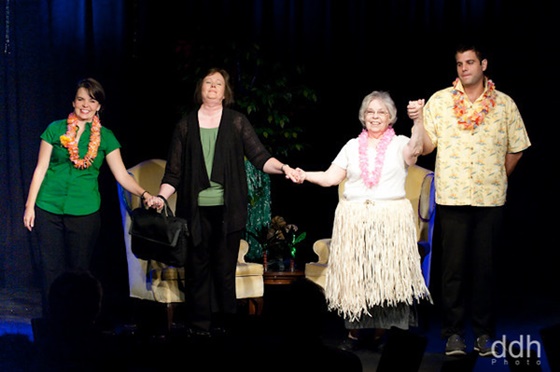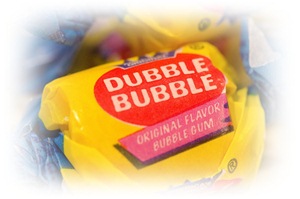Here are some photos from one of the performances of No, Not Really last weekend. More can be seen at the Center on the Square website.




Here are some photos from one of the performances of No, Not Really last weekend. More can be seen at the Center on the Square website.




I got my first prescription eyeglasses when I was 15 years old. I don’t remember the occasion for having my eyes tested. I wasn’t having double vision or headaches. And this was 1948, years before people were into “wellness” visits to health professionals. I was raised during WWII, when half the doctors were in the military forces. We didn’t call the doctor unless we were sick or had ominous symptoms. Then he would drop by to check us out. But, I digress.
The eye, ear, nose and throat practitioner I visited found me to have astigmatism, which is an irregular curvature of the cornea. Also, some other malady with a long name that meant my depth perception wasn’t up to snuff. I might have trouble judging distance. I didn’t think much about it at the time but it does explain a lot. As a kid, I could not hit a soft ball … or catch one unless it was lobbed to me so slowly I had time to think it over before trying to catch it.
NOTHING about sports came naturally to me. “She couldn’t hit a basketball with a tennis racquet,” was a comment that would apply. I might miss a volley ball coming right at me. And in other areas of my life, I often over-filled a glass of milk or wore bruises on my body from running into the edges of tables.
Of course, when I was a child, no one thought, “Bless her heart, she has no depth perception. Let’s make accommodations for her so she won’t be the last one chosen at recess.” (For those of you who do not know what recess is, Google it.)
After the first week, the uniqueness of wearing glasses faded and I seldom put them on (I was a teenager, remember). But as I got older I wore them more often until I realized that although no correction in the lenses was visible to the naked eye, I could see better when I wore my specs.
I have to say that with the lenses my vision is corrected enough to improve my hand-eye coordination. I can thread a needle and insert a plug into an electrical socket. I can text a message if you’re not in a hurry. But I still can’t seem to swat a fly. My best bet is that the pesky insect will die of fright from WHAP that comes so close.
And now, 60+ years since that first pair of eyeglasses, I am completely sold on vision correction. I have bifocals for reading, tri-focals for the computer, sunglasses to keep out the glare and even older bent-up frames for watching TV in bed. And when I step off a curb that turns out to be higher than I thought, I have a ready excuse. It’s not that I’m getting older. I just have a little problem with depth perception.
 While enjoying TCM’s 31 Days of Oscar (see previous post) I caught the 1933 version of Louisa Mae Alcott’s Little Women, starring Katherine Hepburn as Jo March. Ms. Hepburn, one of my favorite actors, was young in 1933 and really chewed the scenery trying to pull off the character of the tom boy sister in this rendition of the 1868 novel. But more about that some other time. What caught my attention as I watched was that she was also chewing gum. “Is this out of character?” I asked myself. “Had chewing gum even been invented during the Civil War?”
While enjoying TCM’s 31 Days of Oscar (see previous post) I caught the 1933 version of Louisa Mae Alcott’s Little Women, starring Katherine Hepburn as Jo March. Ms. Hepburn, one of my favorite actors, was young in 1933 and really chewed the scenery trying to pull off the character of the tom boy sister in this rendition of the 1868 novel. But more about that some other time. What caught my attention as I watched was that she was also chewing gum. “Is this out of character?” I asked myself. “Had chewing gum even been invented during the Civil War?”
Not knowing the answers to my questions, I went to tried and true Google.com. It seems chewing gum has existed for over 5,000 years. Five-thousand-year-old gum, with tooth imprints, has been found in archeological digs in Finland. The chaw was made out of bark tar and thought to have medicinal advantages.
How did pre-historic man find out it had medicinal advantages? I can’t imagine. Perhaps some caveman thought to himself, “I’m really feeling lousy. I think I’ll chew some bark tar . . . ahh, that’s better.” But I digress. Back to chewing gum.
We were all told at one time or another that we shouldn’t swallow our gum, lest it stay in our stomach for 7 years. Not true. That is an old wives tale used by mothers for centuries to scare their kids. Gum will travel out of the body just like any other food. However, gum base cannot be digested, so the trip may take a little longer. But not 7 years.
Fleer invented the first bubble gum. It was pink because that was the only food coloring they had on hand at the time. But this gum was not a success because it was too sticky. In 1928, a Fleer’s employee discovered a sticky-free bubble gum by accident, as happens with many inventions. The company named it Dubble Bubble and it stuck around for several years. (excuse the pun.) In 1951 TOPPS added baseball cards to their gum packages, giving Dubble Bubble significant competition.
Chewing gum has brought humanity a lot of enjoyment with other side benefits. On an airplane, the chewing can keep your ears from popping. Gum decreases the tears while you are cutting onions. After a meal, gum helps prevent heartburn. It has long been used as a breath-freshener. One of the first gums marketed with this in mind was Adam’s Clove Gum with the slogan, “It takes your breath away.”
Chewing gum has its critics also. Almost unanimously the criticism is that chewers do not dispose of the product appropriately.
Many teachers do not allow gum in the classroom. Chewing gum, the product and the act, is illegal in Singapore. Since 2004 gum of therapeutic value is allowed. Gum can be bought only with a doctor’s prescription. The Soviet Union had a ban on gum for many years, lifted in 1976.
With satisfaction, I clicked on the red X and left the site, knowing more than I ever needed to know about chewing gum.
Thank you, Mr. Google, wherever you are. There’s no limit to your knowledge.
 The third Advent candle is that of proclamation … which reminds us of our responsibility to share the Good News of Jesus Christ. Sometimes a pink candle is used for the third candle to symbolize the great joy felt at the proclaiming of the news.
The third Advent candle is that of proclamation … which reminds us of our responsibility to share the Good News of Jesus Christ. Sometimes a pink candle is used for the third candle to symbolize the great joy felt at the proclaiming of the news.
The angels gave the news to the shepherds who went to Bethlehem to see for themselves. Their reaction was to tell everyone they met what they had seen and heard. The tidings the angels brought were not only for the shepherds, not only for Israel, but for the whole world.
Go, tell it on the mountain
Over the hills and everywhere;
Go, tell it on the mountain
That Jesus Christ is born! -John W. Work, Jr. 1872-1925
 The second candle on the Advent Wreath, lit this morning in worship services, is the candle of Preparation. Some narratives call it the Peace candle.
The second candle on the Advent Wreath, lit this morning in worship services, is the candle of Preparation. Some narratives call it the Peace candle.
Before John the Baptist was born, God called him to be the ‘voice in the wilderness’ — to prepare the way of the Lord.
Meanwhile, Mary received a stunning message from the angel. He told her she was chosen by God for a wonderful task — “You will give birth to a son, and you will name him Jesus.”
“How can this be,” Mary asked the angel, “since I am a virgin?”
The angel assured her that with God all things are possible.
Trusting God to work out the details, Mary prepared herself to be the mother of The Promised One.